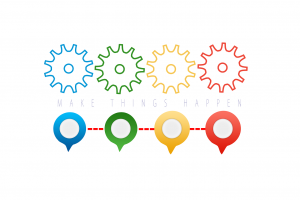The impacts of COVID-19 are being felt throughout the U.S. right now and one of those is the fact that many people who previously commuted to an office are at least temporarily working from home, some for the first time. While this surge in work from home employees may only last for a relatively short time, I also wouldn’t be surprised if many new companies embrace the policy going forward. As someone who has worked from home exclusively for the last few years, I thought I would provide a few useful tips for people who are entering this new territory in their workplace culture and environment.
First off, let me say that I love working from home. It suits my work style, personality, and role with my company. It may be that your situation is very different in any of those areas or others. However, I think these strategies should be beneficial for just about anyone adapting to a remote work environment.
You Must Be Disciplined
This is the single most important part of being both happy and successful in a work from home situation. For many managers and companies, a hesitation they may have had around letting their team members work from home is the idea that they won’t actually work as much as at the office. This is certainly a fair point. Working from home naturally introduces a whole host of new distractions and situations that may pull employees away from their jobs.
One big key for new home-based workers is the ability to shift from home to work mode, while not actually leaving the house. The daily commute and office setting help people make this transition. But, if you work from home, your commute may simply involve getting out of bed and walking to your home office or kitchen table. The fact that you’re working in a place where you previously were able to decompress and get into personal mode may feel a bit strange initially. This is where discipline first comes in. You have to make the switch regardless and be able to stay focused during the day, when distractions like your TV, dog, kids, significant other, etc. are right there. This takes discipline and focus.
But, the flip side of this is that people who work from home can also fall into a situation where they are now at the ‘office’ all the time. It may suddenly become easier to work earlier and later every day. Your evening family time might now be pushed aside in order to finish up a project, answer emails, or otherwise stay caught up with work. You also may find that without the distraction of interacting with other team members or needing to leave the ‘office’ to get lunch, you spend much more time in front of your computer.
Neither situation (being easily distracted or working 24/7) will make your work from home situation successful in the short or long term. So, you need to find ways to stay focused while you’re ‘at work’ but also unplug after hours. Whether this means simply adopting the same work hours you had when you went to the office or setting an alarm for yourself in the morning and evening, find a way to keep some level of balance between your work and home life.
Use Tools like Slack to Stay Connected
One challenge that many remote workers encounter is feeling disconnected from their company and co-workers and potentially even loneliness. You aren’t going to be able to walk over to a team member’s office (or vice versa) and have a quick chat about a work topic or even last night’s baseball game. This can be a real adjustment for even fairly introverted people and if you are more of an extrovert it really can be challenging.
While it isn’t a true substitute for in-person conversations, there are plenty of communication and collaboration tools that can help address feelings of disconnection. Platforms like Slack or similar chat-based systems can do a great job of keeping team members connected on work-related topics and also provide a social outlet for just catching up and chatting about personal topics. When it comes to projects, there are numerous tech platforms like Google Docs, Confluence, Hive, etc. that support collaboration on projects and documents. Hopefully, your company has already adopted many of these tools or will do so to better support remote team members. Make sure you are taking full advantage of them. While they aren’t a complete replacement for in-person contact, they can go a long way toward helping everyone feel more connected.
Set up an Office Space
This ties into being disciplined and it may or may not be as readily available to every home-based employee. One good way to help separate your work and home life is to set up a specific place in your home that will function as your dedicated workspace. The best-case scenario is likely a dedicated home office with a door you can close. This allows you to closely approximate your actual work environment, with a desk and other typical office supplies.
However, if you don’t have a spare room that you can use as a dedicated home office, look for another area of your house, apartment, etc. that can feel separate from the rest of the house. This isn’t to say you can’t have a laptop and work from the couch in your living room, but that is also an area that is likely to offer the most distractions during the day. It might be setting up a small desk in the corner of your bedroom, or setting up in the dining room that you don’t use very often. Whichever option you choose, try to set up a semi-permanent location that you can identify as your ‘office’ and it should help you maintain that separation from the rest of your home.
Embrace the Positives
While the last few points may have seemed to focus on the challenges of working from home, there are also plenty of benefits. As I mentioned previously, I absolutely love working from home and wouldn’t change it, even if there was an office for me to commute to each day. Here are just a few obvious benefits to keep in mind.
- No commute – Who enjoys commuting to an office every day? I know people who spend 1-2 or more hours per day in their cars just driving to and from work. You get to add all that time back into your day. This alone can be a life-changing experience for people making the shift to working from home.
- No dress code – Want to wear shorts and a t-shirt to work every day? Chances are you have that option when you work from home. Even if you need to jump on video calls during the day and need to look presentable, no one knows if you’re in shorts and flip flops out of view of your webcam. Take advantage of this benefit and be comfortable!
- You pick your office atmosphere – Like to crank up the music while you’re working? Want the heat turned up or down? Lights up or dimmer? Basically anything you can control in your home environment is now also under your control for your work environment.
There are tons of others that may apply to you as well. You might be able to throw in a load of laundry in the middle of the day, run to the grocery store over lunch, or take care of other quick household chores when you need a short break. All of these offer real benefits that aren’t available when you commute to an office.
Working from home isn’t for everyone and I’m sure many people who are required to work remotely in the upcoming weeks or months may find it not to their liking. They may breathe a big sigh of relief when they get to go back to their old working routine at the company office. But, I also bet there are a lot of people who will enjoy the experience and may just push their companies to let them continue working from home either permanently or at least more often than previously.
Business & Finance Articles on Business 2 Community
(61)
Report Post






